Compact Quad-Port MIMO Antenna with Ultra-Wideband and High Isolation
Abstract
:1. Introduction
2. Design of UWB Antenna Unit
2.1. Antenna Structure Design
2.2. Design Procedure
2.3. Key Parameters Analysis
2.4. Simulation Results Analysis
3. Quad-Port UWB MIMO Antenna Design
3.1. MIMO Antenna Structure
3.2. S-Parameters Analysis
4. Result and Discussion
4.1. S-Parameters
4.2. Far-Field Characteristics
4.3. Diversity Properties of MIMO Antennas
4.3.1. Envelope Correlation Coefficient
4.3.2. Diversity Gain
4.3.3. Mean Effective Gain
4.3.4. Total Active Reflection Coefficient
5. Conclusions
Author Contributions
Funding
Data Availability Statement
Conflicts of Interest
References
- Mohamadzade, B.; Simorangkir, R.B.V.B.; Hashmi, R.M.; Lalbakhsh, A. A Conformal Ultrawideband Antenna with Monopole-Like Radiation Patterns. IEEE Trans. Antennas Propag. 2020, 68, 6383–6388. [Google Scholar] [CrossRef]
- Chandel, R.; Gautam, A.K.; Rambabu, K. Tapered Fed Compact UWB MIMO-Diversity Antenna with Dual Band-Notched Characteristics. IEEE Trans. Antennas Propag. 2018, 66, 1677–1684. [Google Scholar] [CrossRef]
- Kumar, A.; Ansari, A.Q.; Kanaujia, B.K.; Kishor, J. A novel ITI-shaped isolation structure placed between two-port CPW-fed dual-band MIMO antenna for high isolation. AEU-Int. J. Electron. Commun. 2019, 104, 35–43. [Google Scholar] [CrossRef]
- Wang, L.; Du, Z.; Yang, H.; Ma, R.; Zhao, Y.; Cui, X.; Xi, X. Compact UWB MIMO antenna with high isolation using fence-type decoupling structure. IEEE Antennas Wirel. Propag. Lett. 2019, 18, 1641–1645. [Google Scholar] [CrossRef]
- Radhi, A.H.; Nilavalan, R.; Wang, Y.; Al-Raweshidy, H.S.; Eltokhy, A.A.; Ab Aziz, N. Mutual coupling reduction with a wideband planar decoupling structure for UWB–MIMO antennas. Int. J. Microw. Wirel. Technol. 2018, 10, 1143–1154. [Google Scholar] [CrossRef] [Green Version]
- Bilal, M.; Shahid, S.; Khan, Y.; Rauf, Z.; Wagan, R.A.; Butt, M.A.; Khonina, S.N.; Kazanskiy, N.L. A Miniaturized FSS-Based Eight-Element MIMO Antenna Array for Off/On-Body WBAN Telemetry Applications. Electronics 2021, 11, 522. [Google Scholar] [CrossRef]
- Modak, S.; Khan, T. A slotted UWB-MIMO antenna with quadruple band-notch characteristics using mushroom EBG structure. AEU-Int. J. Electron. Commun. 2021, 134, 153673. [Google Scholar] [CrossRef]
- Jaglan, N.; Gupta, S.D.; Thakur, E.; Kumar, D.; Kanaujia, B.K.; Srivastava, S. Triple band notched mushroom and uniplanar EBG structures based UWB MIMO/Diversity antenna with enhanced wide band isolation. AEU-Int. J. Electron. Commun. 2018, 90, 36–44. [Google Scholar] [CrossRef]
- Khan, A.; Bashir, S.; Ghafoor, S.; Qureshi, K.K. Mutual Coupling Reduction Using Ground Stub and EBG in a Compact Wideband MIMO-Antenna. IEEE Access 2021, 9, 40972–40979. [Google Scholar] [CrossRef]
- Rekha, V.S.D.; Pardhasaradhi, P.; Madhav, B.T.P.; Devi, Y.U. Dual Band Notched Orthogonal 4-Element MIMO Antenna with Isolation for UWB Applications. IEEE Access 2020, 8, 145871–145880. [Google Scholar] [CrossRef]
- Kumar, S.; Lee, G.H.; Kim, D.H.; Mohyuddin, W.; Choi, H.C.; Kim, K.W. Multiple-input-multiple-output/diversity antenna with dual band-notched characteristics for ultra-wideband applications. Microw. Opt. Technol. Lett. 2020, 62, 336–345. [Google Scholar] [CrossRef]
- Khan, A.A.; Naqvi, S.A.; Khan, M.S.; Ijaz, B. Quad port miniaturized MIMO antenna for UWB 11 GHz and 13 GHz frequency bands. AEU-Int. J. Electron. Commun. 2021, 131, 153618. [Google Scholar] [CrossRef]
- Tiwari, R.N.; Singh, P.; Kanaujia, B.; Srivastava, K. Neutralization technique based two and four port high isolation MIMO antennas for UWB communication. AEU-Int. J. Electron. Commun. 2019, 110, 152828. [Google Scholar] [CrossRef]
- Mu, W.; Lin, H.; Wang, Z.; Li, C.; Yang, M.; Nie, W.; Wu, J. A Flower-Shaped Miniaturized UWB-MIMO Antenna with High Isolation. Electronics 2022, 11, 2190. [Google Scholar] [CrossRef]
- Sohi, A.K.; Kaur, A. A complementary Sierpinski gasket fractal antenna array integrated with a complementary Archimedean defected ground structure for porTable 4G/5G UWB MIMO communication devices. Microw. Opt. Technol. Lett. 2020, 62, 2595–2605. [Google Scholar] [CrossRef]
- Wu, L.; Cao, X.; Yang, B. Design and Analysis of a Compact UWB-MIMO Antenna with Four Notched Bands. Prog. Electromagn. Res. M 2022, 108, 127–137. [Google Scholar] [CrossRef]
- Rajkumar, S.; Amala, A.A.; Selvan, K. Isolation improvement of UWB MIMO antenna utilising molecule fractal structure. Electron. Lett. 2019, 55, 576–579. [Google Scholar] [CrossRef]
- Khan, A.A.; Saeed Khan, M.; Naqvi, S.A.; Ijaz, B.; Asif, M.; Ali, E.M.; Khan, S.; Lalbakhsh, A.; Alibakhshikenari, M.; Limiti, E. Printed Closely Spaced Antennas Loaded by Linear Stubs in a MIMO Style for Portable Wireless Electronic Devices. Electronics 2021, 10, 2848. [Google Scholar] [CrossRef]
- Agarwal, S.; Rafique, U.; Ullah, R.; Ullah, S.; Khan, S.; Donelli, M. Double Overt-Leaf Shaped CPW-Fed Four Port UWB MIMO Antenna. Electronics 2021, 10, 3140. [Google Scholar] [CrossRef]
- Mezzanotte, P.; Roselli, L.; Sorrentino, R. A simple way to model curved metal boundaries in FDTD algorithm avoiding staircase approximation. IEEE Microw. Guided Wave Lett. 1995, 5, 267–269. [Google Scholar] [CrossRef]
- Telzhensky, N.; Leviatan, Y. Novel method of UWB antenna optimization for specified input signal forms by means of genetic algorithm. IEEE Trans. Antennas Propag. 2006, 54, 2216–2225. [Google Scholar] [CrossRef]
- He, Z.; Jin, J.; Zhang, Y.; Duan, Y. Design of A Two-Dimensional “T” Shaped Metamaterial with Wideband, Low Loss. IEEE Trans. Appl. Supercond. 2019, 29, 1–4. [Google Scholar] [CrossRef]
- Sultan, K.S.; Abdullah, H.H. Planar UWB MIMO-Diversity Antenna with Dual Notch Characteristics. Prog. Electromagn. Res. C 2019, 93, 119–129. [Google Scholar] [CrossRef] [Green Version]
- Iqbal, A.; Saraereh, O.A.; Ahmad, A.W.; Bashir, S. Mutual coupling reduction using F-shaped stubs in UWB-MIMO antenna. IEEE Access 2017, 6, 2755–2759. [Google Scholar] [CrossRef]
- Khan, A.A.; Jamaluddin, M.H.; Nasir, J.; Khan, R.; Aqeel, S.; Saleem, J. Owais. Design of a dual-band MIMO dielectric resonator antenna with pattern diversity for Wimax and Wlan applications. Prog. Electromagn. Res. M 2016, 50, 65–73. [Google Scholar] [CrossRef] [Green Version]
- Rafique, U.; Agarwal, S.; Nauman, N.; Khalil, H.; Ullah, K. Inset-fed Planar Antenna Array for Dual-band 5G MIMO Applications. Prog. Electromagn. Res. C 2021, 112, 83–98. [Google Scholar] [CrossRef]
- Chouhan, S.; Panda, D.K.; Gupta, M.; Singhal, S. Multiport MIMO antennas with mutual coupling reduction techniques for modern wireless transreceive operations: A review. Int. J. RF Microw. Comput. Eng. 2018, 28, e21189. [Google Scholar] [CrossRef]
- Fritz-Andrade, E.; Jardon-Aguilar, H.; Tirado-Mendez, J.A. The correct application of total active reflection coecient to evaluate MIMO antenna systems and its generalization toNports. Int. J. RF Microw. Comput. Eng. 2020, 30, e22113. [Google Scholar]
- Bhatia, S.S.; Sharma, N. Modified Spokes Wheel Shaped MIMO Antenna System for Multiband and Future 5G Applications: Design and Measurement. Prog. Electromagn. Res. C 2021, 117, 261–276. [Google Scholar] [CrossRef]

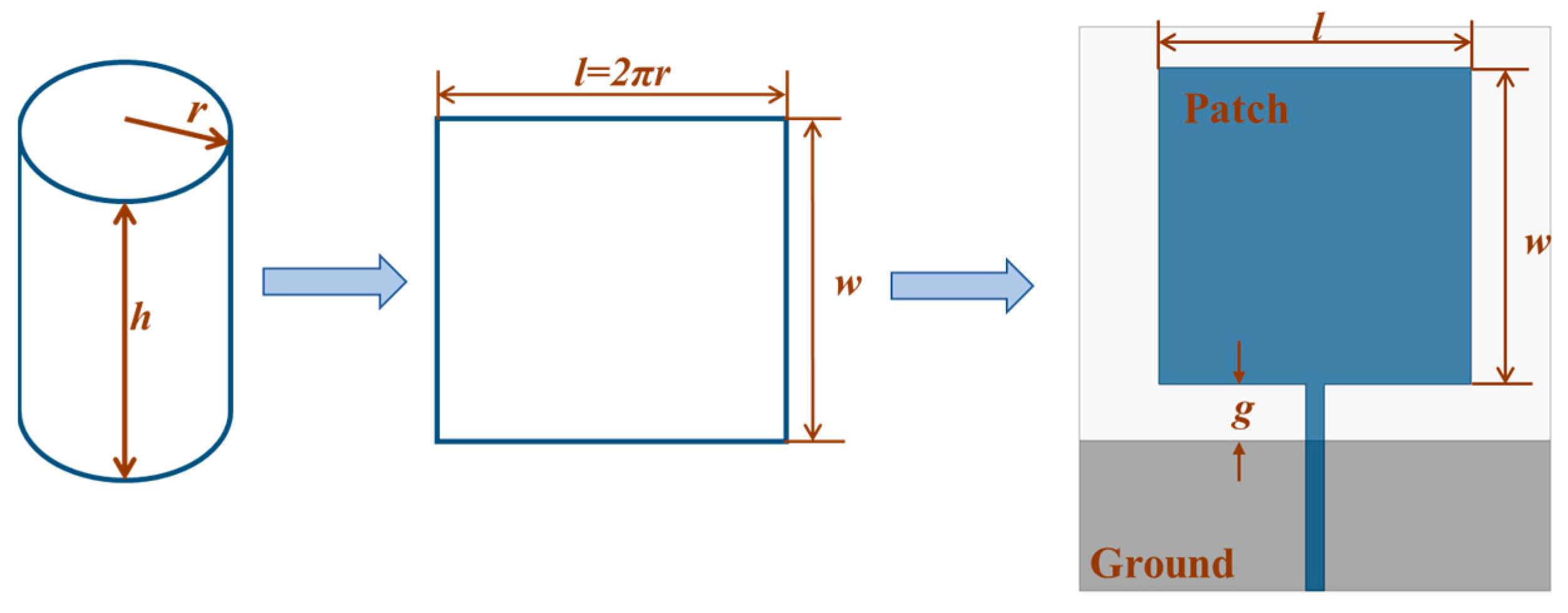

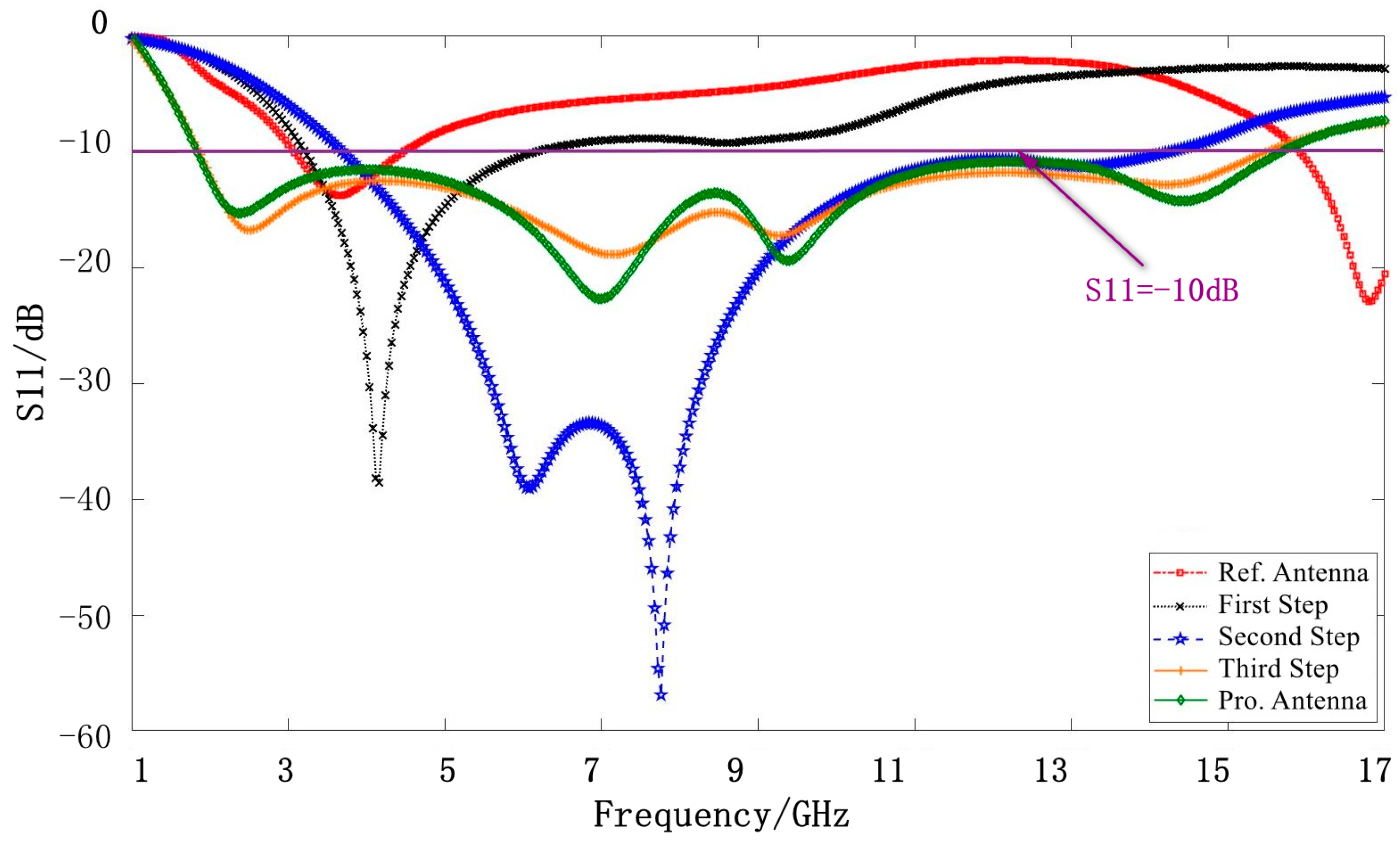
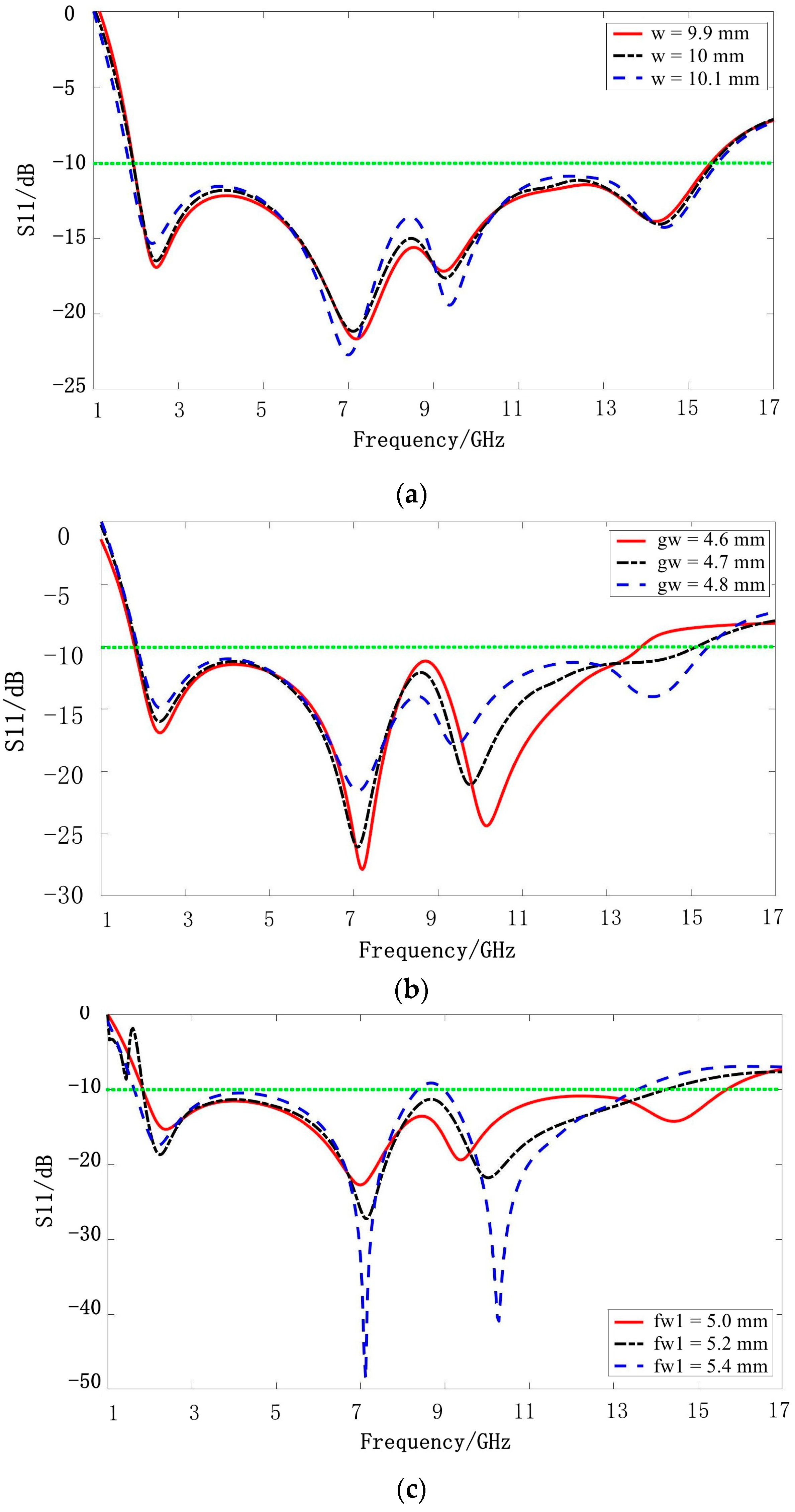



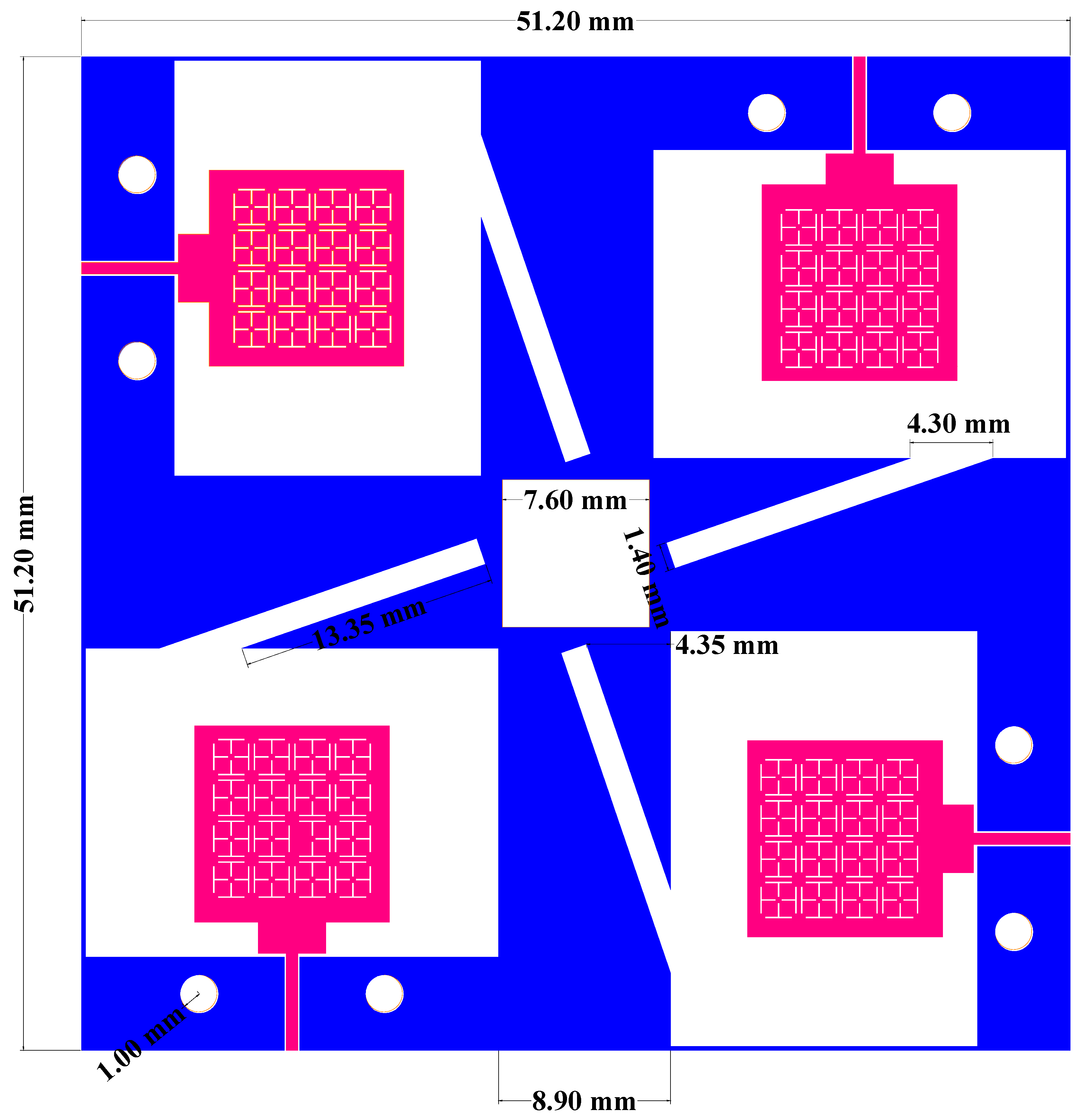

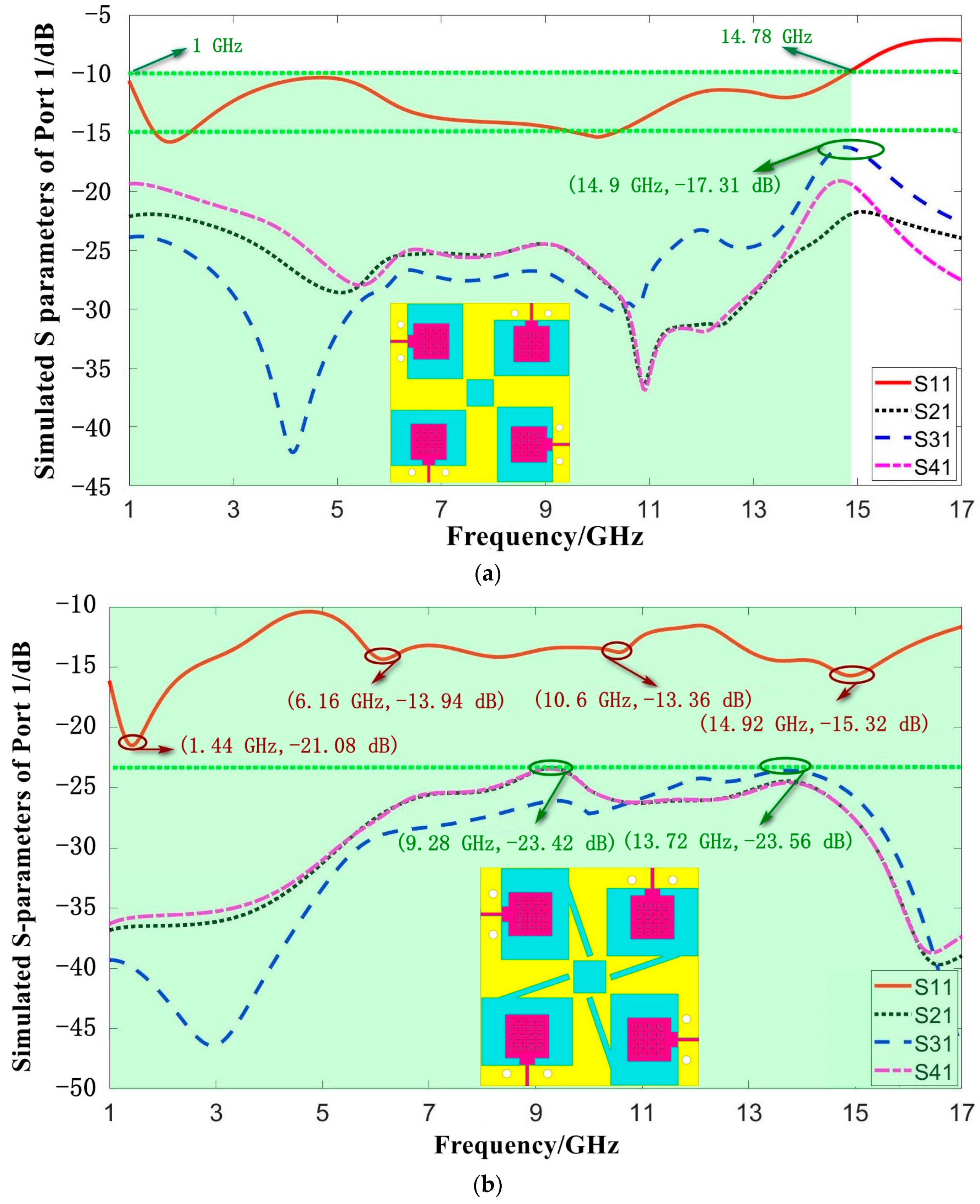
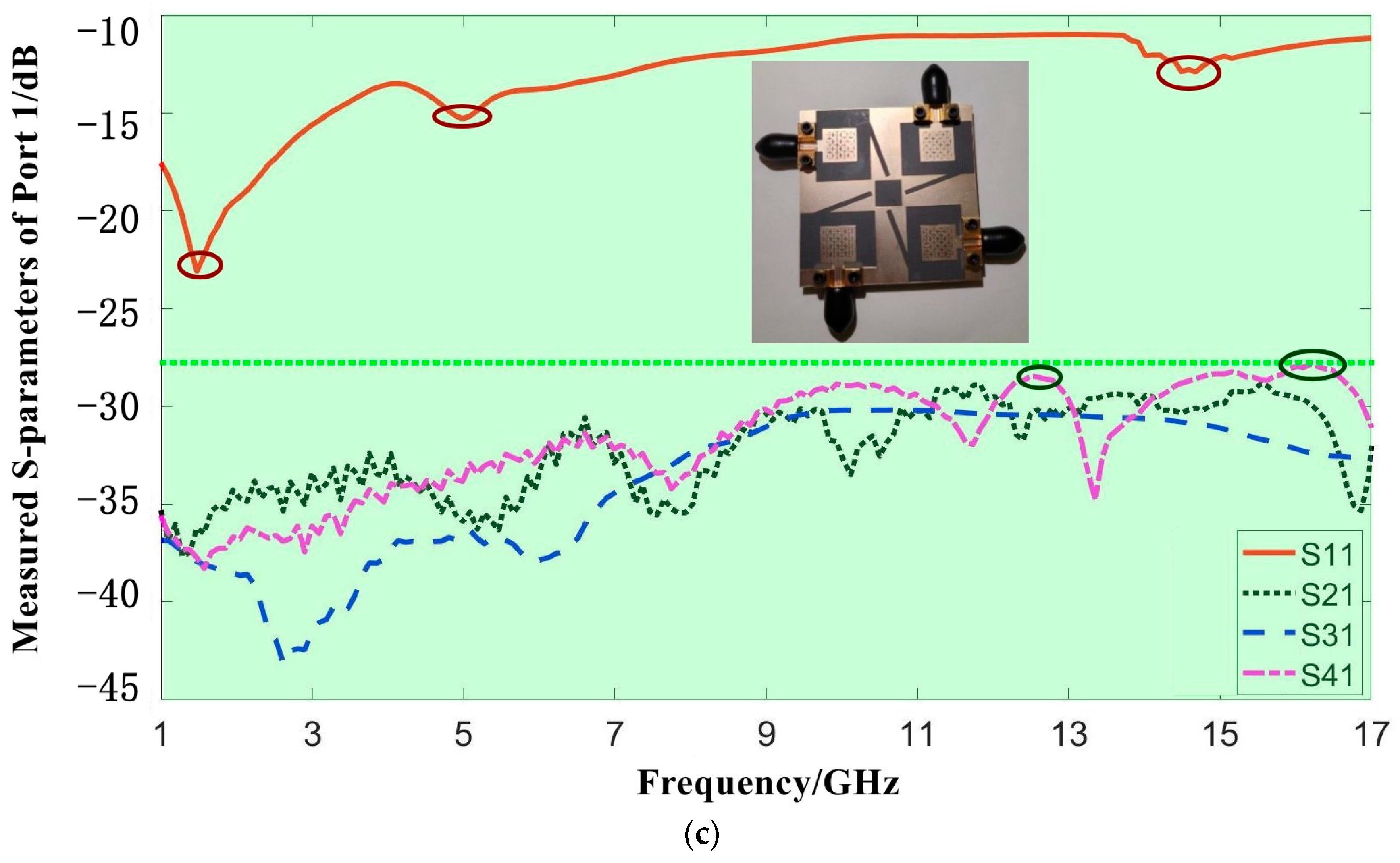
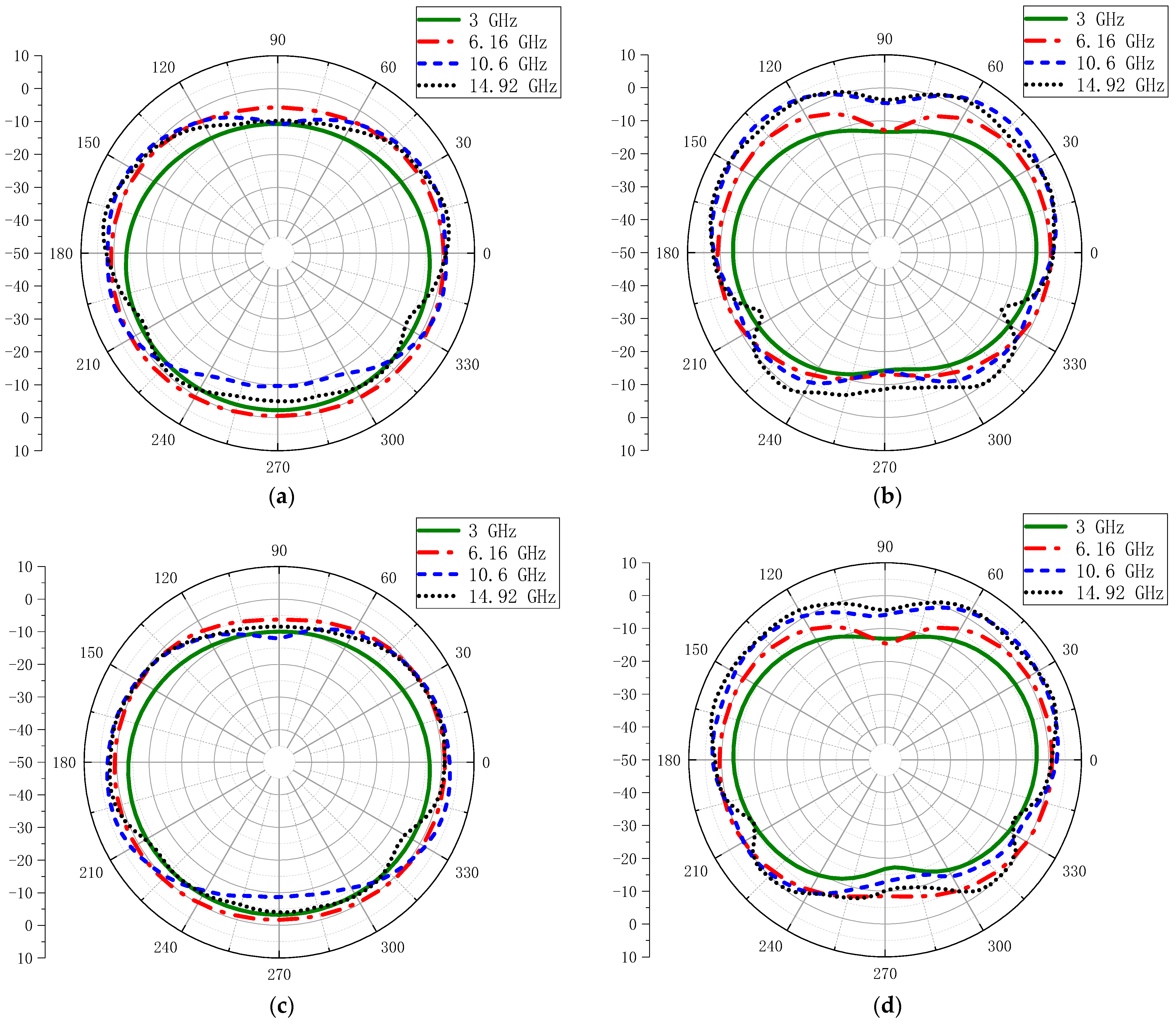

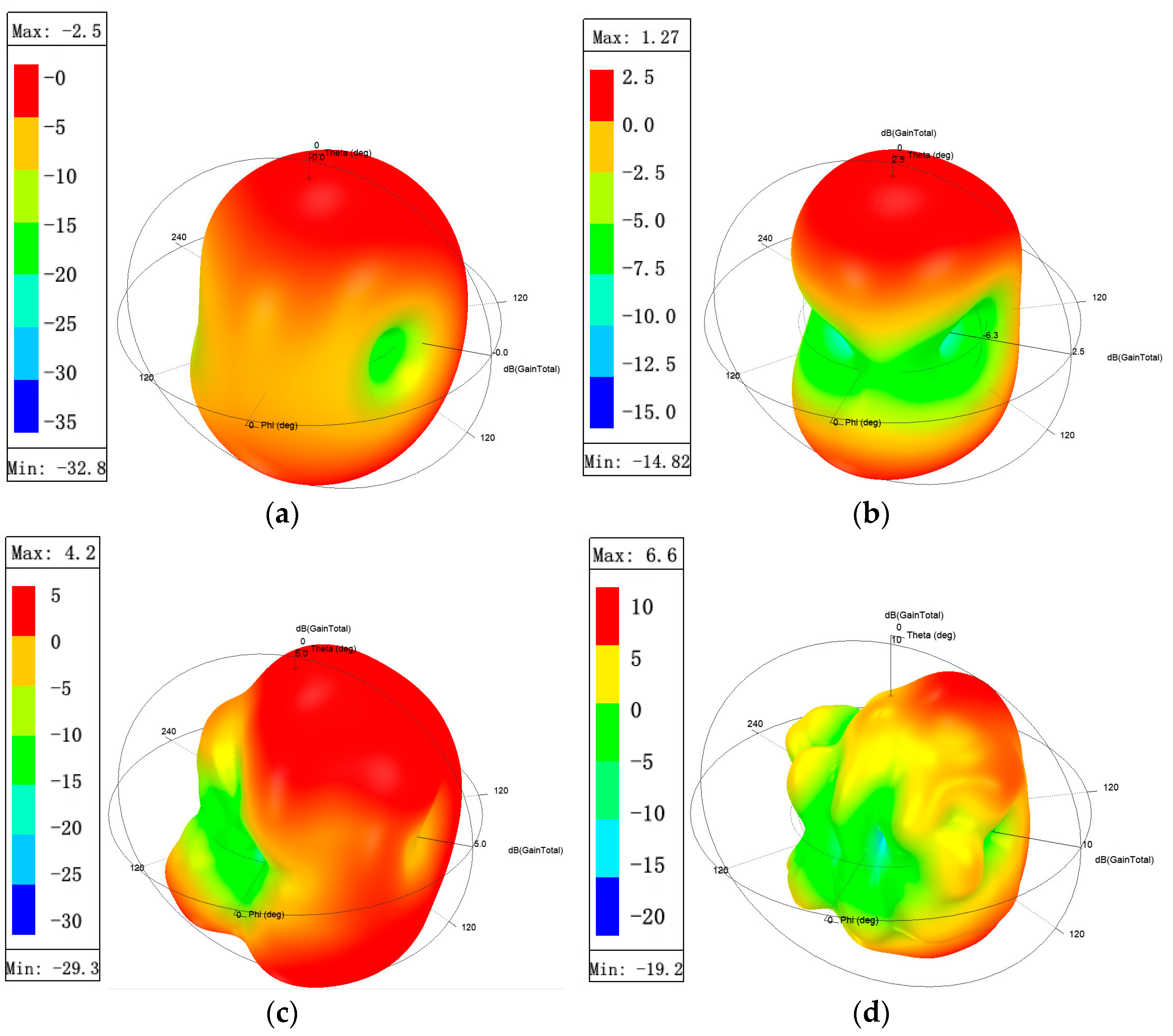

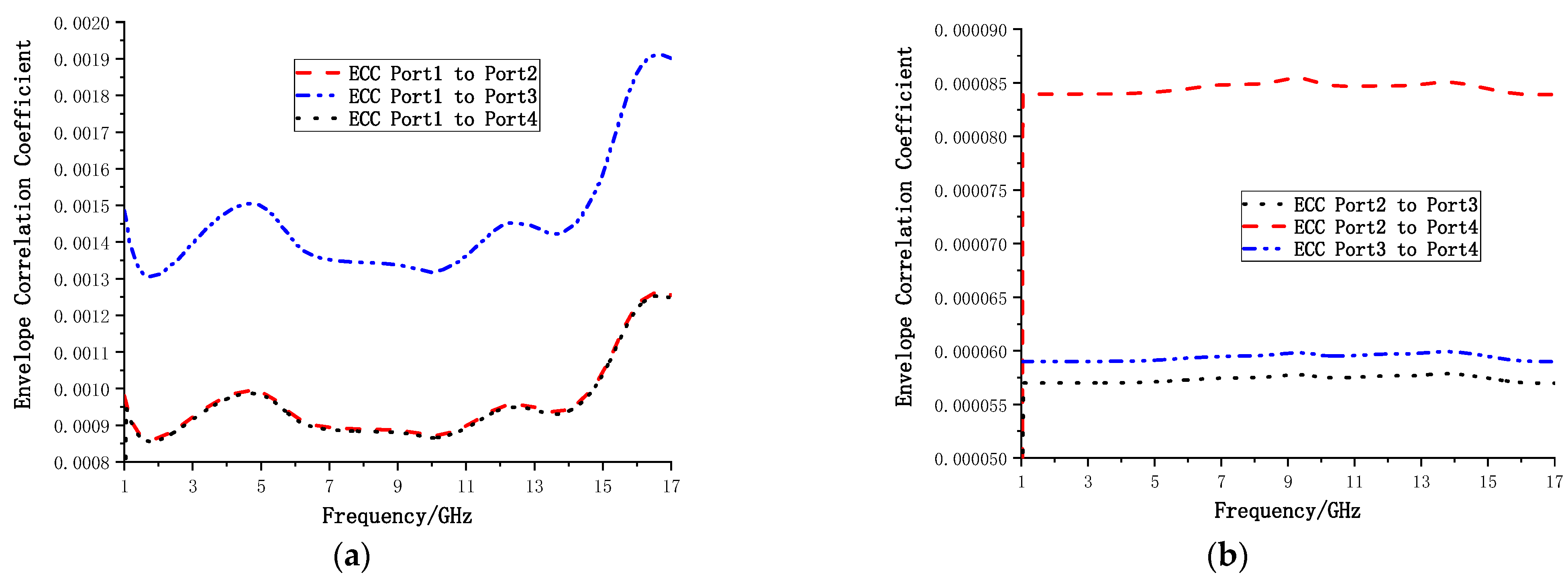

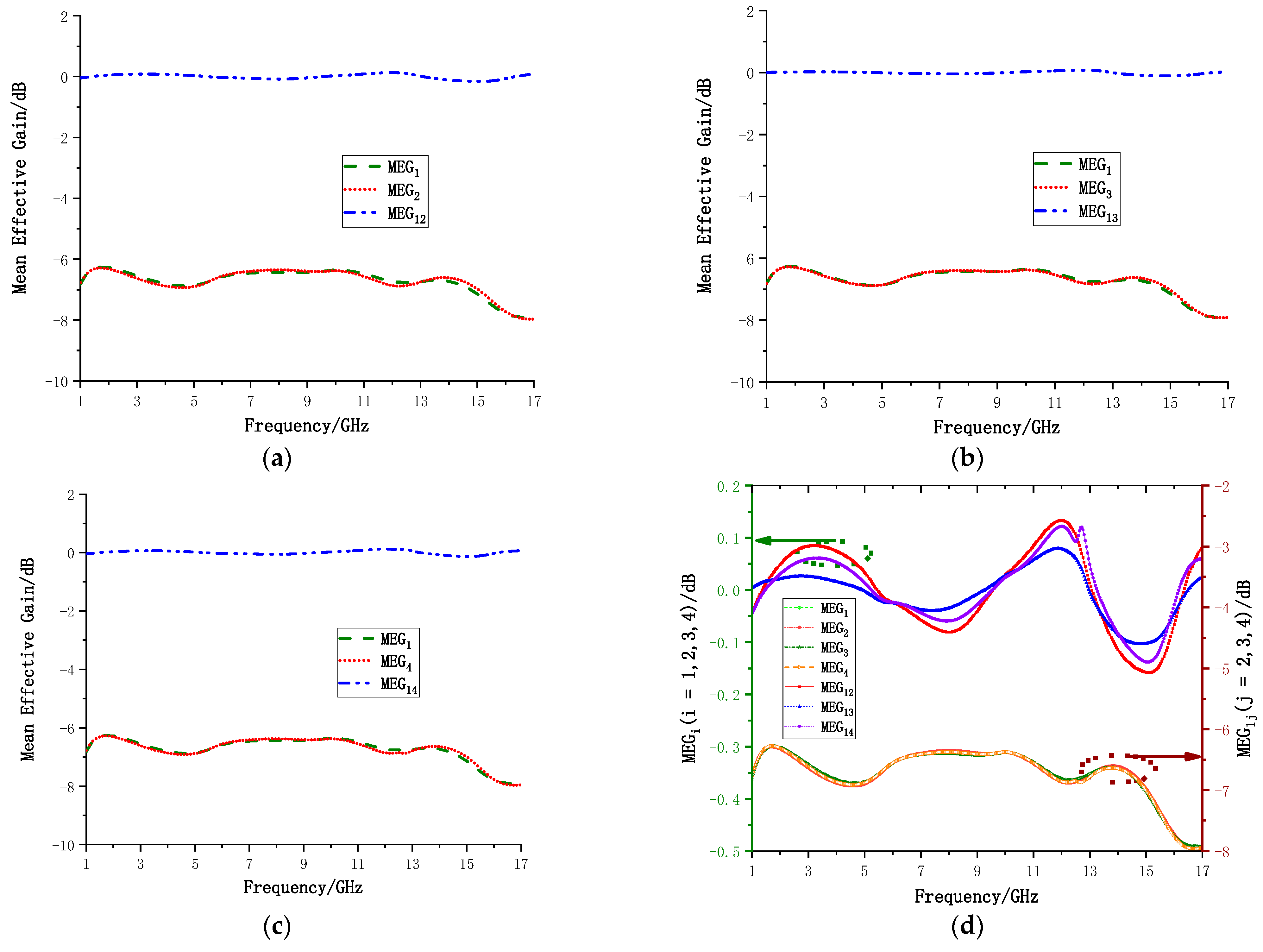
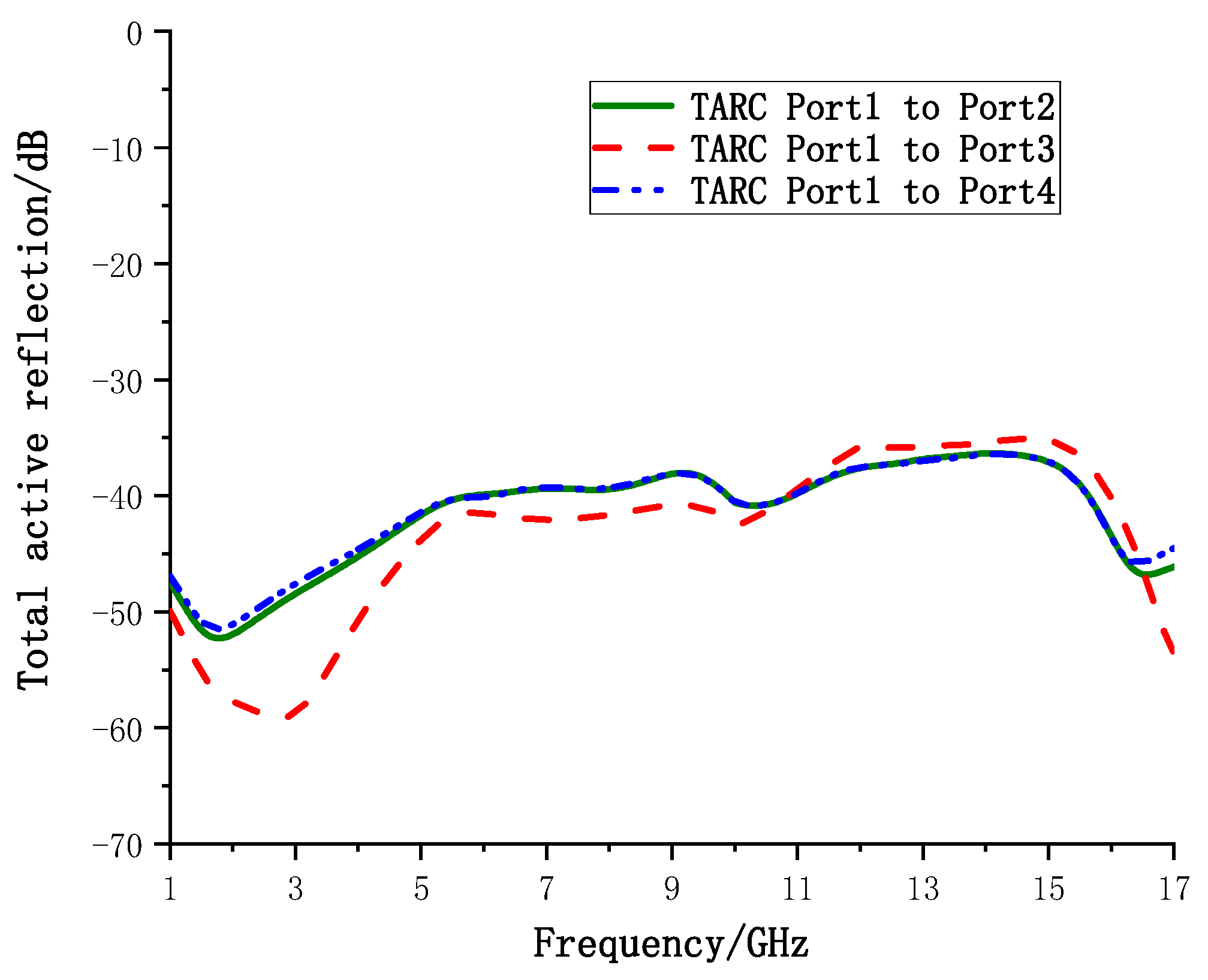
| Parameters | L | W | l | w | W1 | gw | fw1 | fw2 | gl | fl1 | fl2 | m |
|---|---|---|---|---|---|---|---|---|---|---|---|---|
| Value/mm | 21.8 | 25.63 | 9.94 | 10.1 | 13.32 | 4.81 | 5 | 1.4 | 10.5 | 0.6 | 3.5 | 1.45 |
| Isolation | Minimum/dB | Maximum/dB |
|---|---|---|
| Port 1 to 2 | 23.72 | 39.27 |
| Port 1 to 3 | 23.46 | 46.77 |
| Port 1 to 4 | 23.71 | 37.14 |
| Ref. | Operation Band/GHz | Isolation/dB | ECC | Size/mm2 | Unit No. | Unit Size/mm2 |
|---|---|---|---|---|---|---|
| [3] | 2.33–6.71 | >24 | <0.036 | 2 | 1960 | |
| [4] | 3–11 | >25 | <0.004 | 2 | 875 | |
| [5] | 3.1–10.6 | >31 | <0.035 | 2 | 2185.5 | |
| [7] | 3–10.7 | >25 | ≤0.01 | 2 | 750.35 | |
| [10] | 2.1–20 | >25 | <0.02 | 4 | 1600 | |
| [11] | 2.8–13.3 | >18 | <0.06 | 72 × 72 | 4 | 1296 |
| [12] | 3–13.5 | >15 | <0.4 | 40 | 4 | 400 |
| [15] | 4.3–11.6 | >15.8 | <0.007 | 41 | 2 | 2037.7 |
| [16] | 2.7–11.22 | >20 | <0.035 | 30.75 | 2 | 581.175 |
| [19] | 2.75–16.05 | >20 | <0.006 | 4 | 756.25 | |
| Pro. | 1–17 | >27.8 | <0.002 | 4 | 655.36 |
Publisher’s Note: MDPI stays neutral with regard to jurisdictional claims in published maps and institutional affiliations. |
© 2022 by the authors. Licensee MDPI, Basel, Switzerland. This article is an open access article distributed under the terms and conditions of the Creative Commons Attribution (CC BY) license (https://creativecommons.org/licenses/by/4.0/).
Share and Cite
He, Z.; Jin, J. Compact Quad-Port MIMO Antenna with Ultra-Wideband and High Isolation. Electronics 2022, 11, 3408. https://doi.org/10.3390/electronics11203408
He Z, Jin J. Compact Quad-Port MIMO Antenna with Ultra-Wideband and High Isolation. Electronics. 2022; 11(20):3408. https://doi.org/10.3390/electronics11203408
Chicago/Turabian StyleHe, Zhengrui, and Jie Jin. 2022. "Compact Quad-Port MIMO Antenna with Ultra-Wideband and High Isolation" Electronics 11, no. 20: 3408. https://doi.org/10.3390/electronics11203408




